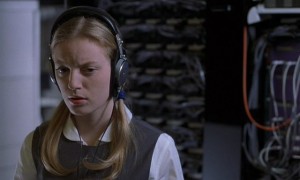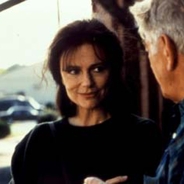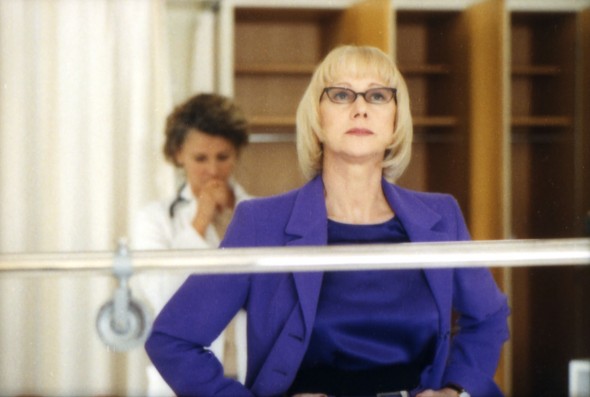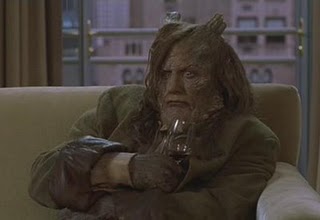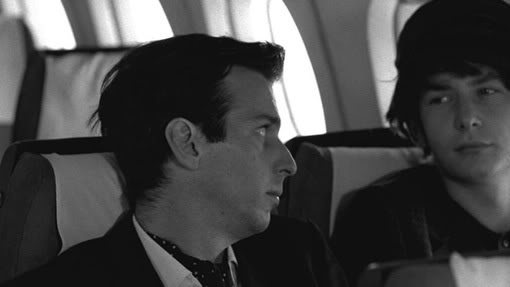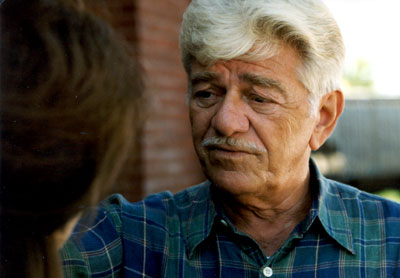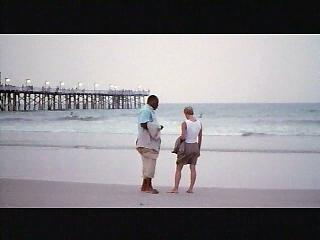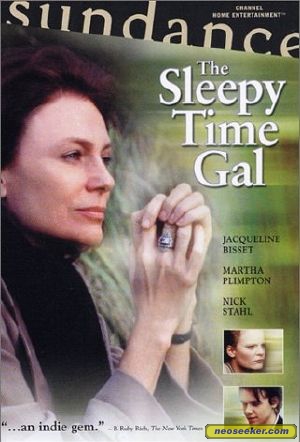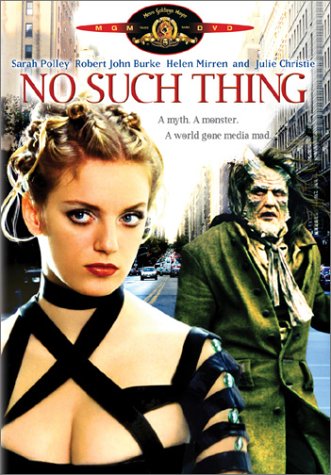From the Chicago Reader (March 29, 2002). — J.R.
No Such Thing ** (Worth seeing)
Directed and written by Hal Hartley
With Sarah Polley, Robert John Burke, Helen Mirren, Baltasar Kormakur, Paul Lazar, Annika Peterson, and Julie Christie
The Sleepy Time Gal *** (A must-see)
Directed and written by Christopher Munch
With Jacqueline Bisset, Martha Plimpton, Nick Stahl, Amy Madigan, Frankie R. Faison, Carmen Zapata, Peggy Gormley, and Seymour Cassel.
On March 29 two new American independent features of some importance will debut. Hal Hartley’s No Such Thing — not one of his best movies — will open at Pipers Alley, and Christopher Munch’s The Sleepy Time Gal, which I prefer, will premiere exclusively on the Sundance cable channel. Chances are, a lot more people will see the Munch film, though they’ll have to be subscribers to the Sundance Channel or have a friend who is.
Considering these two films together is a breach of reviewing etiquette: movies that premiere in theaters are supposed to be in a different category than movies that premiere on TV. I first saw the Munch film, about a woman dying of cancer, last fall on video at the Vancouver International Film Festival, and I remember looking forward to seeing it on the big screen. Now I can only wonder if I’ll ever be able to — and if I can’t I’ll never be able to decide how good it really is, because Munch’s films all have a sense of spectacle that depends in part on the size and definition of the screen image, as well as on the way the images are edited together. (”Edited on film,” the final credits note proudly, reinforcing the idea that a video of a film edit, or an edit seen on a TV screen, may be only an approximation.) A recent second viewing on video reminded me of some of the film’s virtues and flaws without clarifying what its strengths as a big-screen movie might be.
I saw No Such Thing for the first time last week, when it was screened in 35-millimeter. It premiered at Cannes last May, and the only buzz I heard about it was unfavorable; for the most part it was ignored. Its allegorical and satirical story concerns a savage and murderous monster (Robert John Burke) in the wilds of Iceland who’s older than humanity, which he despises, and who wants only to be destroyed — something only a missing mad scientist named Dr. Artaud (Baltasar Kormakur) knows how to accomplish. The monster is tracked down by Beatrice (Sarah Polley), a young New Yorker working for a sensationalist TV news program produced by another kind of monster known as the Boss (well played by Helen Mirren), who thrives on violence and catastrophes. Beatrice is following in the footsteps of her journalist boyfriend, who disappeared with his crew, but she manages to achieve an uneasy truce and friendship with the monster and brings him back to New York, where it turns out Artaud is being held in captivity by the Boss. Eventually the monster, his designated assassin, and Beatrice return to Iceland to negotiate their collective destiny.
The press book for No Such Thing notes that Hartley has recently been staging and restaging his first play, Soon, in Europe and California, which helped me pinpoint what I find unsatisfying about his new feature. Despite a few attractive Icelandic landscapes and a striking rhythmic use of close-ups in the final sequence, his material seems much more suited to the stage than to film. Could it be merely a coincidence that the mad scientist is named Artaud? His monologues and the monster’s might work beautifully onstage — and are certainly well performed, especially by Burke — but they come across in the film as clunky and strident. Even the heavy-handed media satire concentrated in the character of the Boss — satire whose premises I agree with but whose delivery makes me want to defend American TV news — might have worked had it used the direct address of a play to put across its points. The extinct form of live TV drama exemplified by Studio One and Playhouse 90 during the 50s and early 60s, where the audience shared the same existential moment as the actors, might have been all that was needed to put this didactic material across. But in a movie the excessive pontification threatens to overwhelm everything else — as it did in Hartley’s Henry Fool.
Why isn’t The Sleepy Time Gal getting a theatrical release? According to B. Ruby Rich in the New York Times last month, Munch’s film — which was “shown to acclaim” at Sundance in early 2001 and wound up on the Village Voice’s list of the best undistributed films of last year — didn’t get an American release because it was deemed “too European.” “Too European? What does that mean?” asked the film’s incredulous star, Jacqueline Bisset. “That it’s too intelligent?” I think there’s a different reason. After all, No Such Thing is an American-Icelandic production — though Francis Ford Coppola is one of three executive producers — with some Icelandic locations and actors as well as two English actresses, Mirren and Julie Christie (in a cameo as a nurse).
By contrast, The Sleepy Time Gal has American characters and is set in American locations — New York, San Francisco, Daytona Beach, Boston, and rural Pennsylvania — there’s one brief glimpse of a London phone booth. (Bisset, who plays an American, is English, but achieved a letter-perfect American accent after months of careful work.) I also don’t think that the film’s sensibility is European. Munch’s first film, The Hours and Times (1991), dealt with two English lads (John Lennon and Brian Epstein) on a weekend holiday in Barcelona, but he’s still as American as apple pie — or Faulkner — when it comes to speculating about who his characters are and how they operate. So is Hartley, despite his indebtedness to European directors such as Godard. But No Such Thing is a movie about a particular Hollywood genre (the horror film), media feeding frenzies, and various interactions between the two. The Sleepy Time Gal is about life — that of Munch’s own mother, which is evident even without reading articles or interviews about the film. That it’s about Munch’s mother dying of cancer makes it even more about life. And these days we’re often made to feel that TV is supposed to be tackling life while movies are supposed to be about other movies.
Could that be why Henry Bean’s The Believer — another much-praised American independent feature that recently premiered on cable — couldn’t get a distributor? I haven’t caught up with it yet, but its subject, an Orthodox Jewish teenager who becomes a neo-Nazi skinhead, isn’t the sort of thing one expects to finds in movie theaters. I haven’t seen any studies of why films like Bean’s and Munch’s get the bum’s rush from distributors, but I wonder if their unpleasant subject matter has something to do with it. And if that’s the case, I wonder why cable TV is a friendlier venue. After all, schizophrenia — the subject of the Academy Award winner A Beautiful Mind — is unpleasant too. But even when Ron Howard’s movie invites the audience to identify with such a condition it does so by drawing its hallucinations from bad movies — in this case, cliched images such as Ed Harris in a trench coat and science fiction implants. At any rate, TV does seem to gravitate more toward contemporary issues and news than movie theaters do. In the 50s, when live TV drama was more arty and ambitious in terms of style than today’s canned drama, it was Hollywood that kept better pace with current events, in pictures directed by people such as Richard Brooks, Samuel Fuller, Nicholas Ray, Douglas Sirk, and Frank Tashlin.
Which venue a movie appears in plays an important role in how it’s received. Movies that are released theatrically — an infinitesimally small fraction of what’s made — automatically qualify for Oscars and other prizes; ten-best lists; feature articles in newspapers, Premiere, Sight and Sound, and Film Comment; promotional documentaries on TV; and eventually a prominent spot in video stores. Most important, they might be added to the unofficial canon constructed and reinforced by advertising and the media comprising “movies that matter.” But movies that premiere on cable TV are automatically movies that don’t matter, and whether they qualify as works of art or pieces of shit doesn’t make the slightest bit of difference when most critics start holding forth on the State of the Art.
Munch’s second feature, Color of a Brisk and Leaping Day (1996), made less of a lasting impression on me than his first or The Sleepy Time Gal, but all of his singular work is the result of his neat and decorous way of suggesting messy and unruly lives. In spite of the multifaceted nuances and suggestions of Bisset’s performance as Frances, along with those of the characters closest to her — such as her gay photographer son (Nick Stahl as Munch’s surrogate) and a former lover (Seymour Cassel) — it’s the incidental characters who reveal Munch’s talent at its most wonderful: a black radio station manager (Frankie R. Faison), Cassel’s wife (Peggy Gormley), a French girl gathering mushrooms near San Francisco Bay with whom Frances converses, Frances’s racist mother, Frances’s nurse (Amy Madigan). Finally there’s Rebecca (Martha Plimpton) — the daughter Frances had with Cassel, put up for adoption, lost track of, and perpetually yearns for — a corporate lawyer who yearns equally for the mother she never knew.
The core of The Sleepy Time Gal turns out to be the way mother and daughter pursue each other on parallel tracks throughout the picture, without ever meeting — a kind of poetic and mystical mirror dance that evokes the rhyming destinies of a Taiwanese watch salesman in Taipei and one of his clients in Paris in Tsai Ming-liang’s What Time Is It There? (Could this be what’s “too European” about Munch’s picture — a global vision that could just as easily be called Taiwanese or, for that matter, American?) The most curious thing about this two-part narrative is its multifaceted ambiguity. The little we see of Frances’s past is shown in black-and-white photographs and home movies, real or imagined, and at times we can’t be sure whether we’re watching the fantasies of one character or the memories of another. When Rebecca travels to Daytona Beach to handle her company’s purchase of a radio station where Frances once worked as a late-night DJ (the legendary “sleepy time gal” of the title), she allows the middle-aged black station manager to seduce her. Is this her fantasy, the manager’s memory of a onetime fling with Frances, or his fantasy? We can’t tell, and the film’s poetic vision is predicated in part on our lack of certainty about this and other details. Is Rebecca’s trip to Daytona Beach an outlandish coincidence or a seized opportunity?
I’ve called Munch’s style neat and decorous, but the way this movie — a period piece, like his other two features — leaps about in time and space may initially seem restless and unsettled. It starts off with Frances in New York City in the summer of 1982, moves to Frances in San Francisco six months later, leaps to Rebecca in New York, lurches forward another year to Frances in San Francisco, switches to Rebecca in Boston, then follows her as she boards a plane for Daytona Beach. Yet the persistence of feelings and personalities registers more than the temporal and spatial shifts — becoming a duet between mother and daughter, many miles and lives apart, singing in perfectly staggered harmony. This isn’t that different from the way the jazz vocalist and musicians perform “Sleepy Time Gal” on the sound track — or from the rhythmic alternations between Beatrice, the monster, and Artaud in the ridiculous laboratory at the end of No Such Thing. But few people are likely to notice any relationship between the two features, because one is considered cinema and the other isn’t.
Published on 14 Aug 2011 in Featured Texts, Featured Texts, by jrosenbaum



